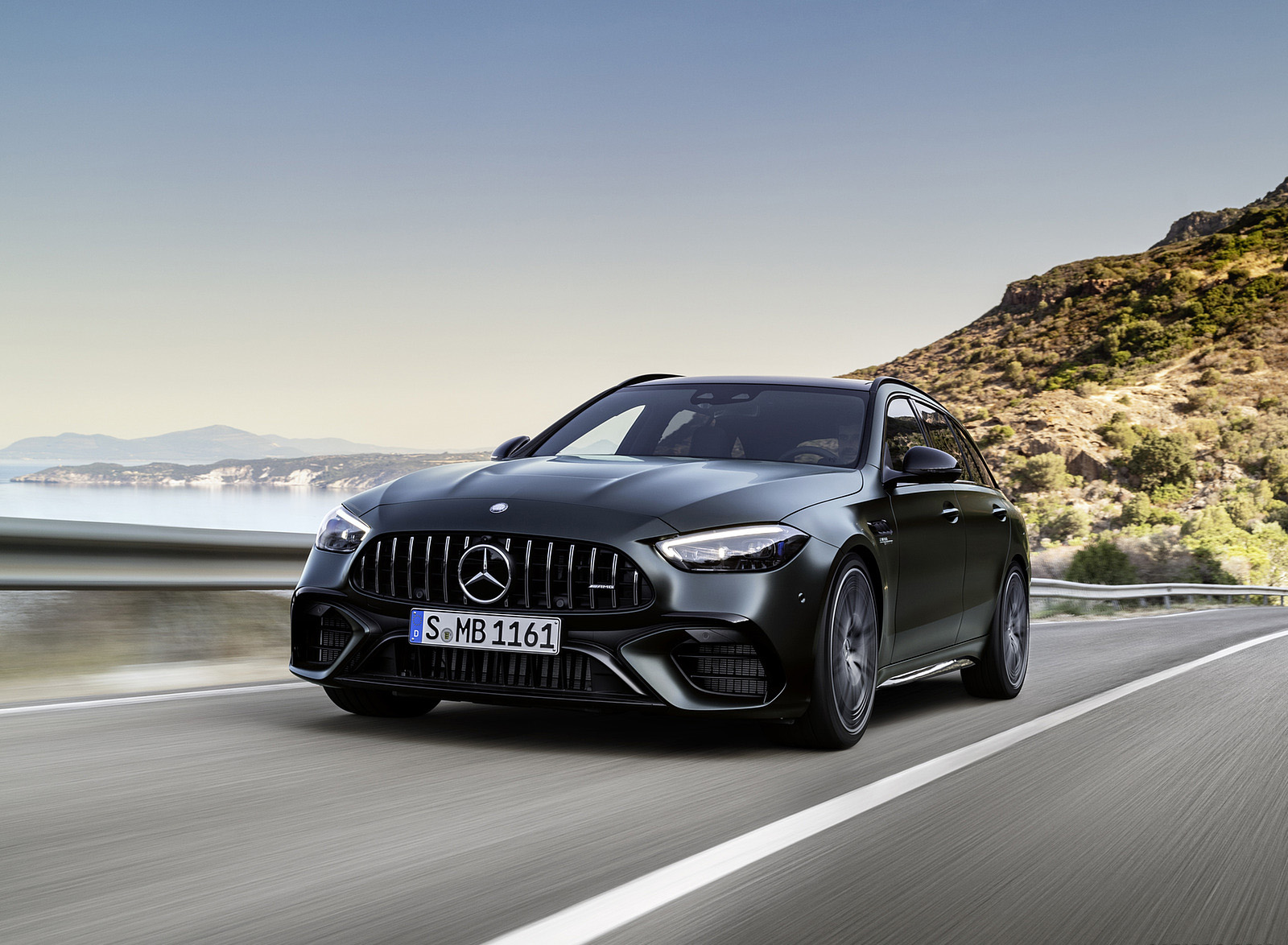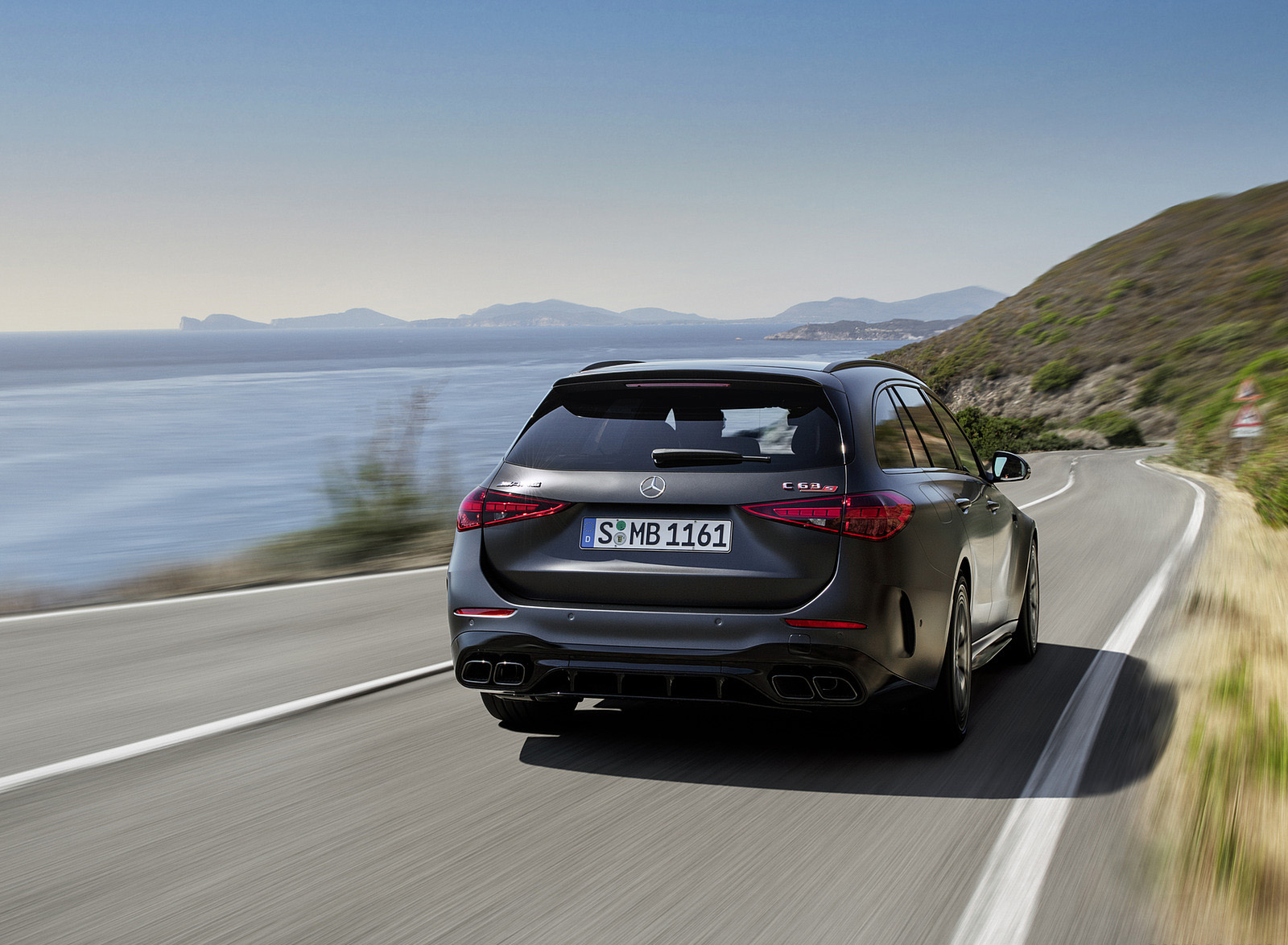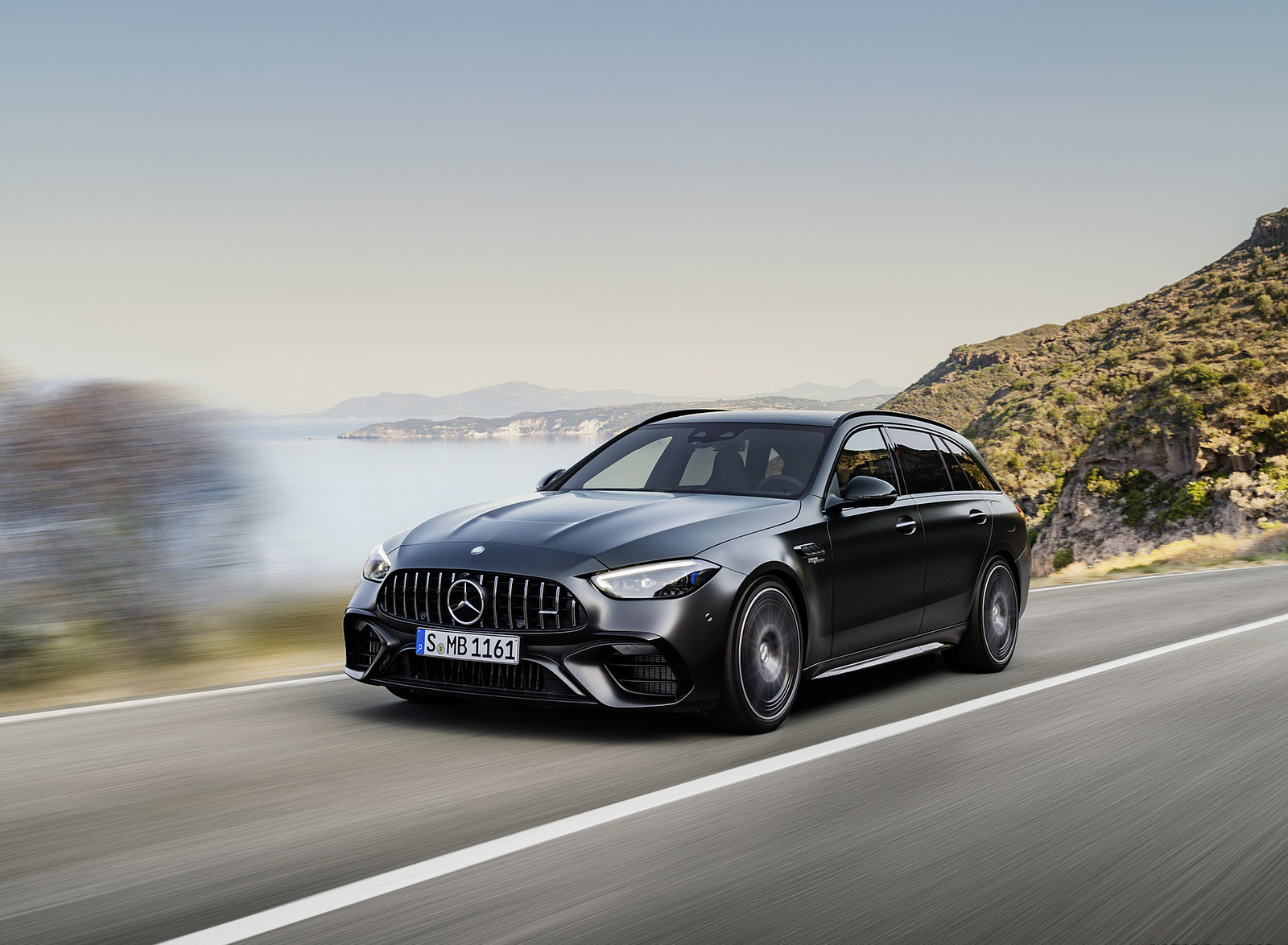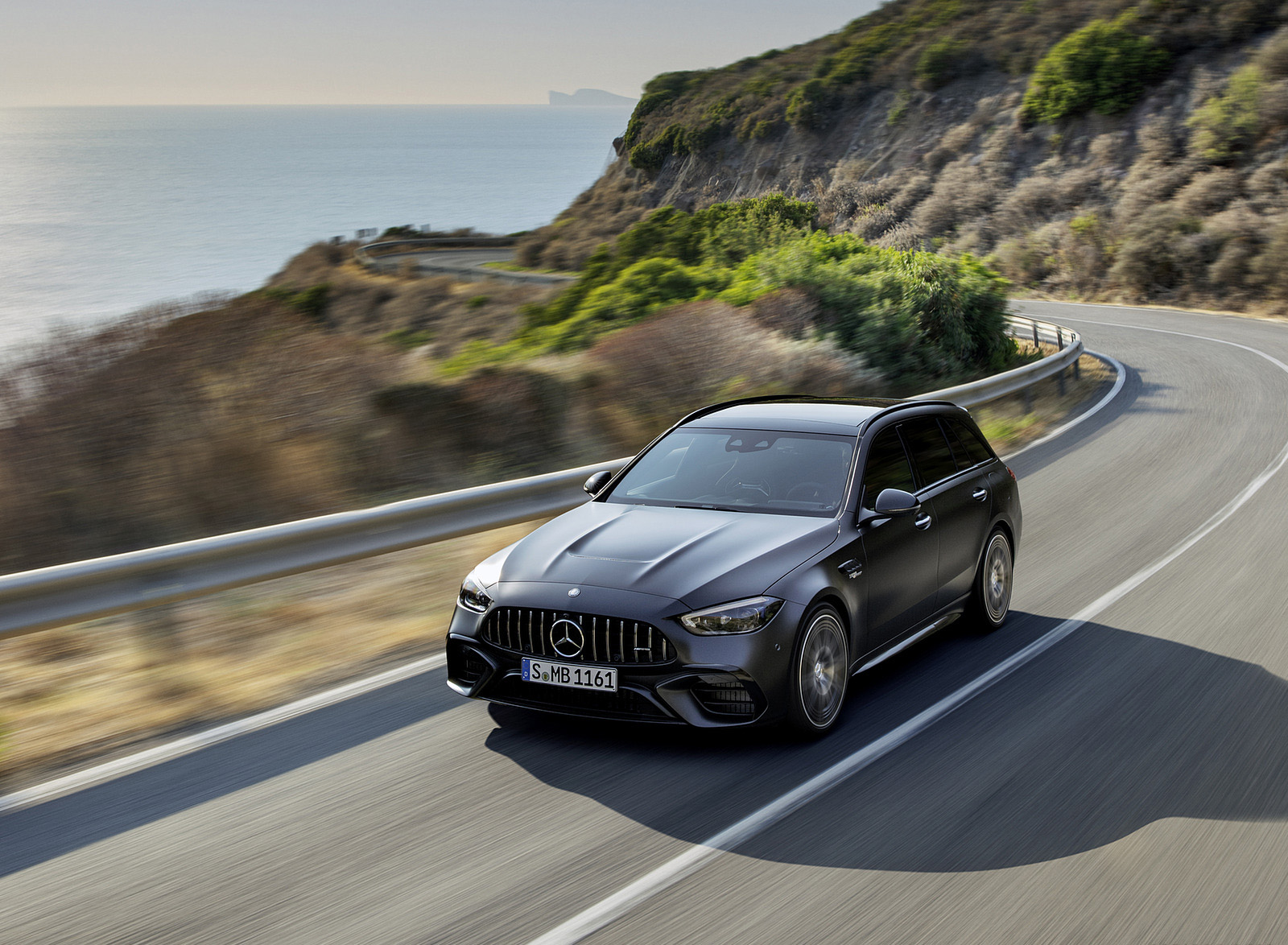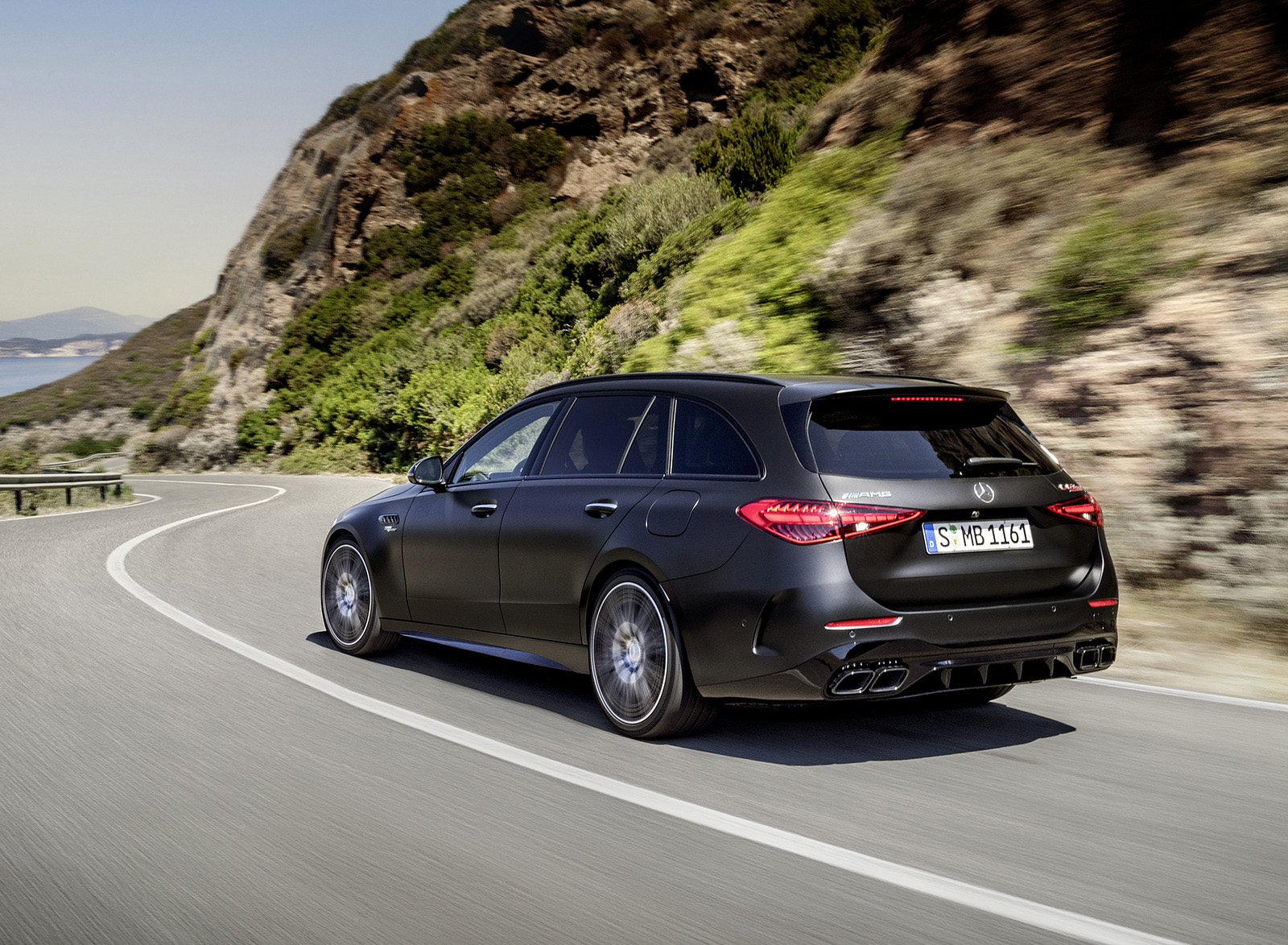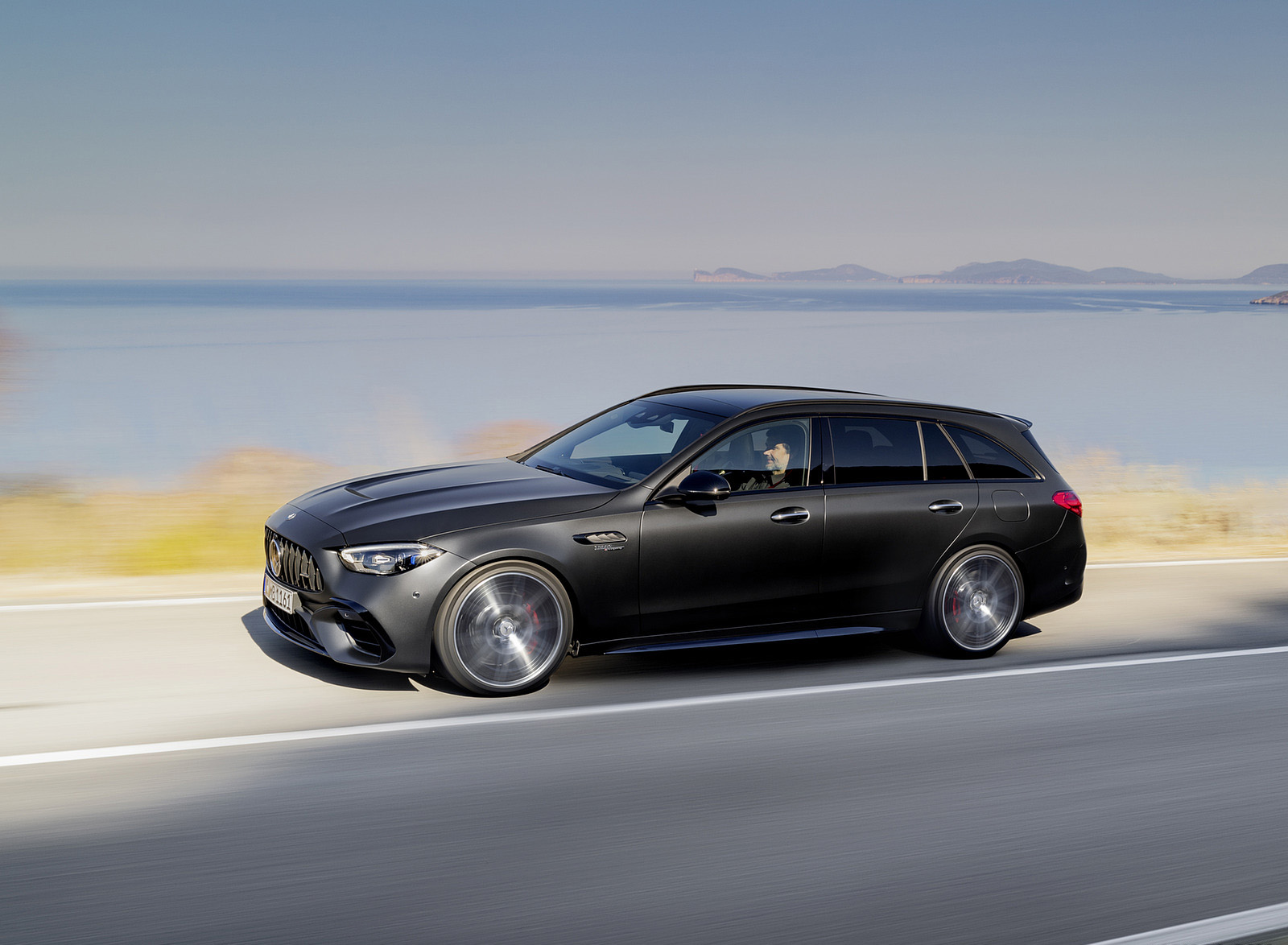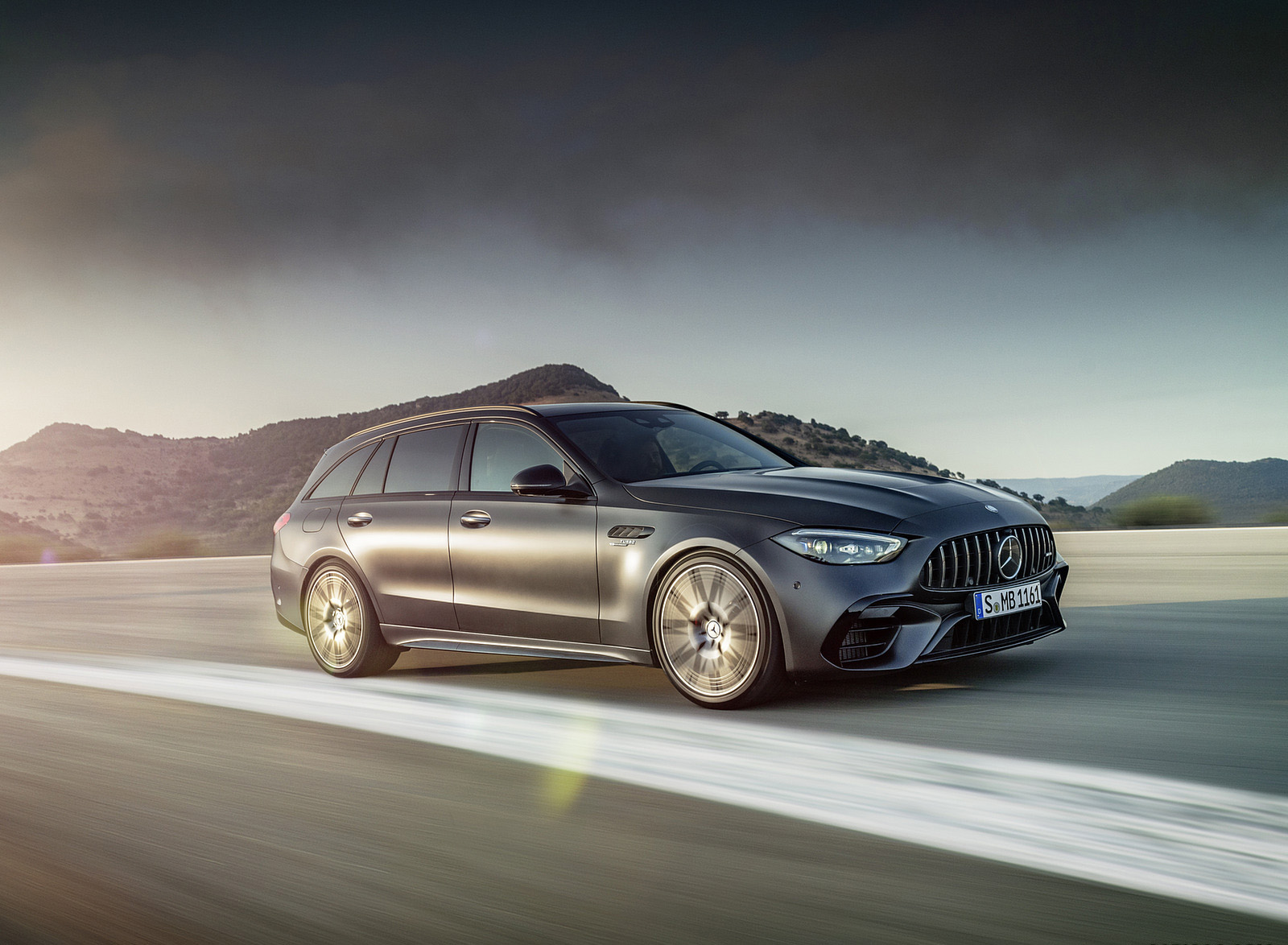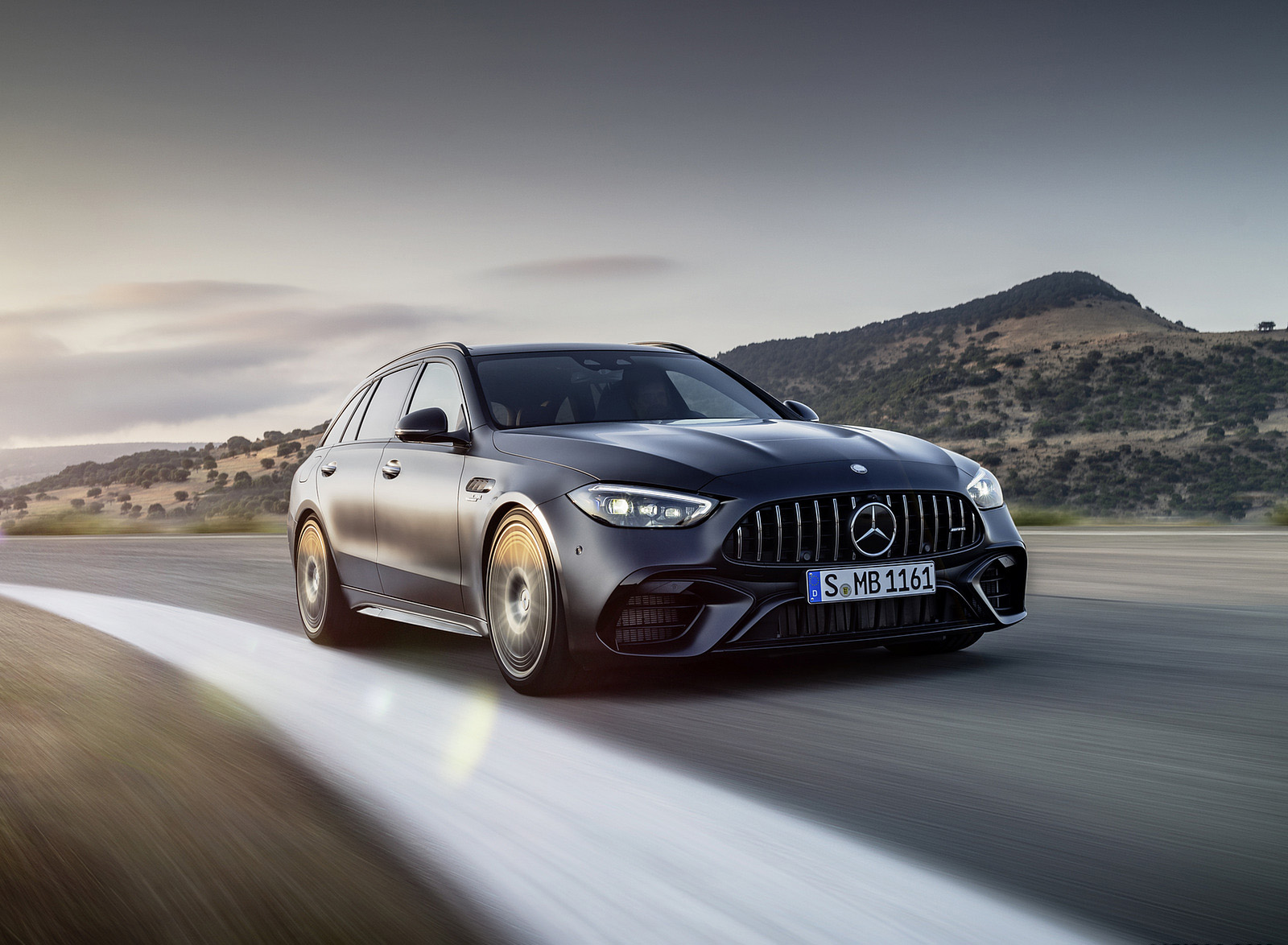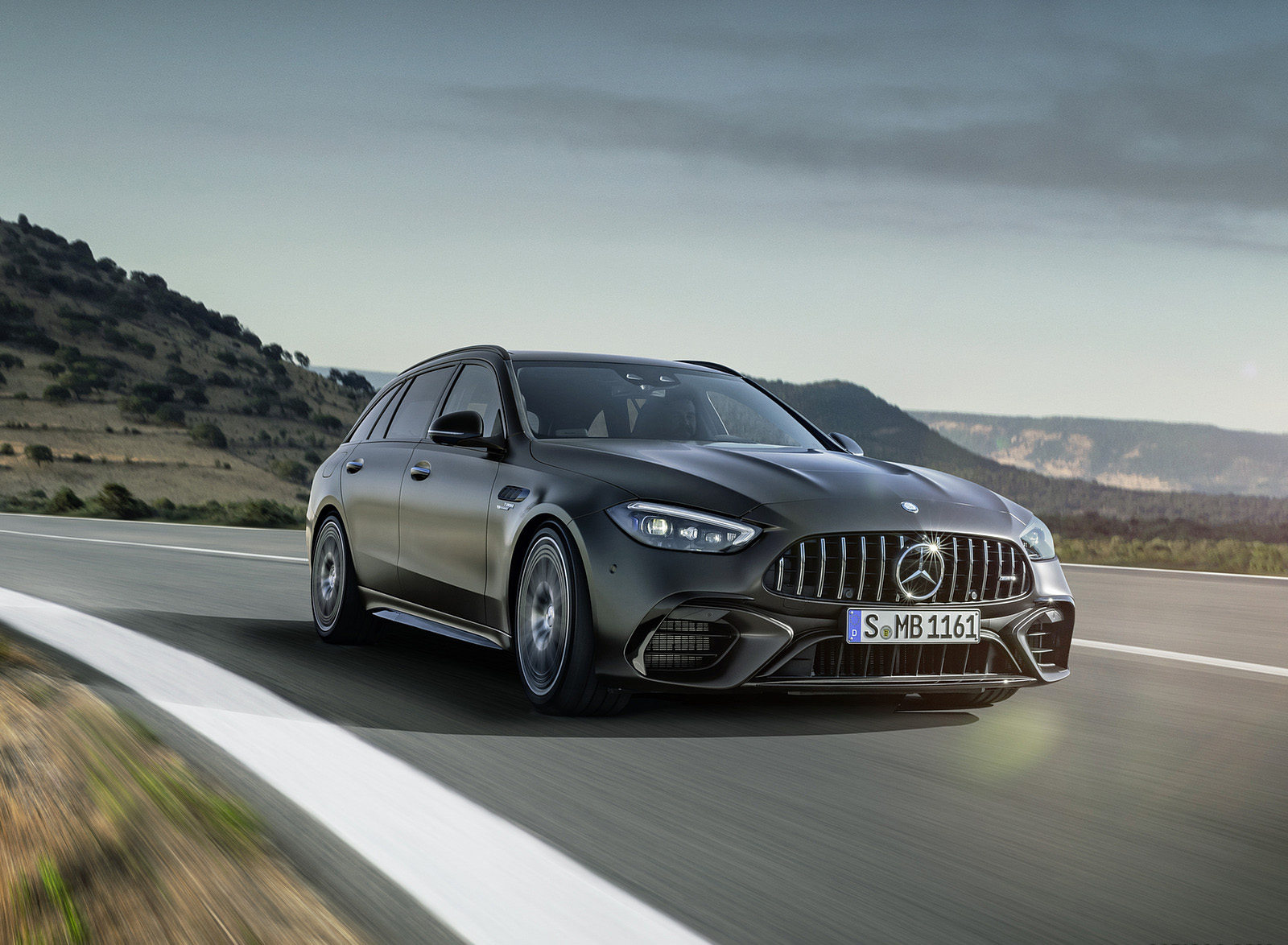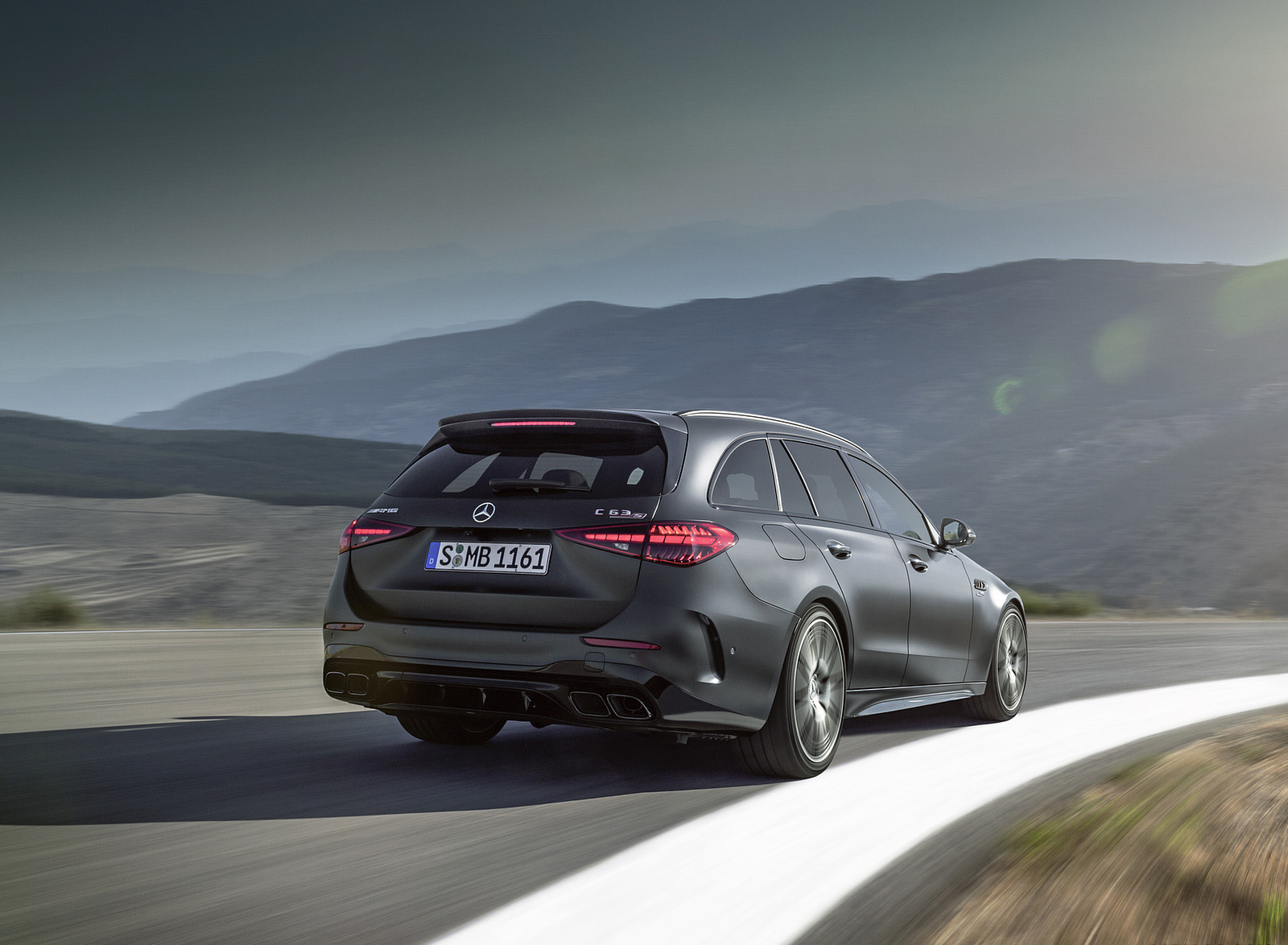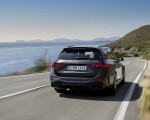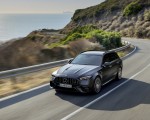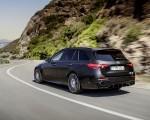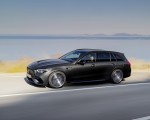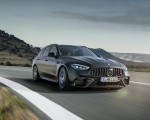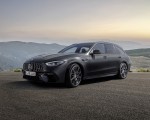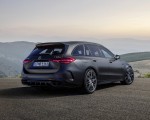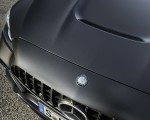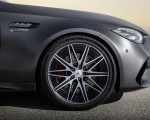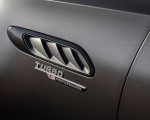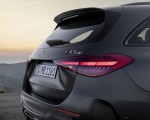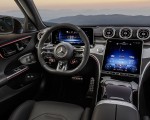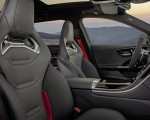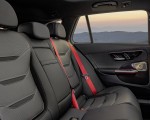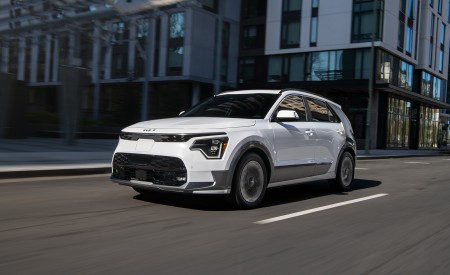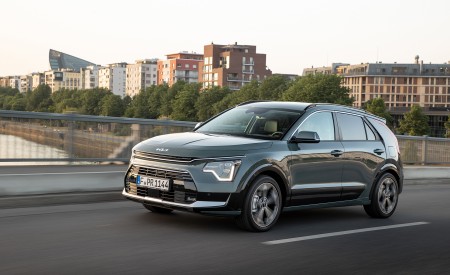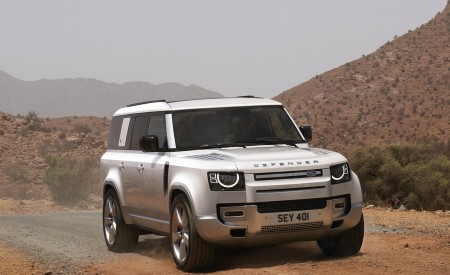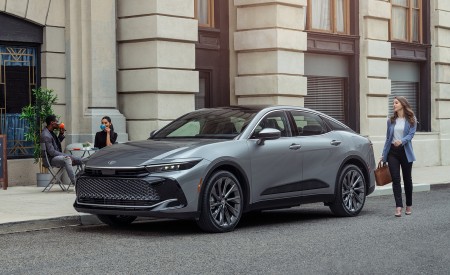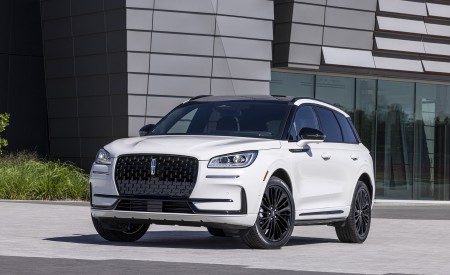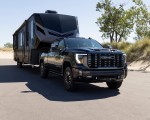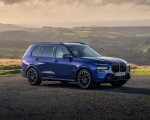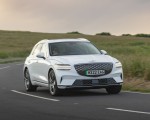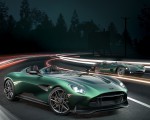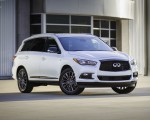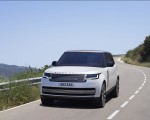2023 Mercedes-AMG C 63 S E Performance Estate
- Performance hybrid with technology transfer from Formula 1™.
- 2.0-litre engine at the front and electric motor on the rear axle for 500 kW (680 hp) system output.
- World’s most powerful four-cylinder engine with an output per litre of 176 kW (238 hp).
- AMG Performance 4MATIC+ fully variable all-wheel drive and active rear axle steering.
The new Mercedes-AMG C 63 S E PERFORMANCE (combined fuel consumption, weighted: 6.9 l/100 km; combined CO2 emissions, weighted: 156 g/km; combined electric energy consumption, weighted: 11.7 kWh/100 km)[1] is a real game changer in the 55-year history of AMG. With know-how from Formula 1™, it brings state-of-the-art technologies from motorsport to the road. A two-speed electric motor positioned on the rear axle supports the 2.0-litre turbo engine that is mounted longitudinally at the front. This is the most powerful production four-cylinder in the world. Power delivery and torque build-up occur very spontaneously and without delay: as in Formula 1™, the electric support of the exhaust gas turbocharger eliminates the turbo lag of the combustion engine, while at the same time the electric drive pushes powerfully from a standstill. The electric powertrain and the high-performance battery with 400 volts are AMG-exclusive, in-house developments. They underline the high-end engineering competence of the Affalterbach-based developers. Just like in Formula 1™, the battery is specifically designed for fast power output and draw with innovative direct cooling of the cells. The combined system output is 500 kW (680 hp), the combined maximum system torque 1020 Nm. These are new peak values for the C-Class.
Other highlights of the new model series, which is being launched simultaneously as a Saloon and as an Estate: for the first time in a C 63, the fully variable all-wheel drive system AMG Performance 4MATIC+ is used to transfer the drive power to the road, and includes a Drift Mode for even more driving pleasure. Added to this is active rear axle steering as standard, another unique feature in this segment.
“With the C 63 S E PERFORMANCE, we are opening a new chapter in the history of our brand. Even 55 years after our company was founded, we at AMG continue to show the boldness and the will to realise the creative, to deliver something special. The new C 63 in particular is a real game changer. With its revolutionary concept, it brings a completely new approach to the segment, which until now has been primarily characterised by the promise purely of performance. With a maximum system output of 680 hp, we do indeed keep this promise. But the intelligent P3 hybrid concept offers much more. I am sure that with this technology, which incorporates a lot of know-how from Formula 1, we will also appeal to a new group of customers”, says Philipp Schiemer, Chairman of the Board of Management of Mercedes-AMG GmbH.
“With its Performance hybrid drive and electrically assisted exhaust turbocharger, the new C 63 S E PERFORMANCE is a technological masterpiece that takes a new approach. The electrified powertrain offers a whole new driving experience. The immediate response of the electric drive at the rear axle, the rapid torque build-up as well as the fast power output and also draw of our battery are very special features. Add to this the standard-fit rear axle steering and the fully variable all-wheel drive with Drift Mode – the new C 63 once again illustrates the high level of technical expertise that AMG possesses”, says Jochen Hermann, Chief Technical Officer of Mercedes-AMG GmbH.
As in Formula 1, the battery is specifically designed for fast power delivery and take-up. The electric range of 13 kilometres allows a practical operating radius, for example in the city or in residential areas.
Expressive design with striking front apron
Form follows function: the design of the new C 63 S differs from that of the Mercedes-Benz C-Class in its more muscular proportions. The Saloon and Estate models are both based on an extensively modified AMG bodyshell. The front end is 50 millimetres longer and the front wings are wider. All in all, the overall exterior dimensions differ considerably from those of the Mercedes-Benz C-Class. In terms of length, the Saloon and Estate measure an extra 83 millimetres. The wider track width at the front axle results in 76 millimetres more overall width at the front. And the wheelbase has grown by ten millimetres. All in all, this results in a layout that gives the new C 63 S a powerful, stretched and muscular look.
A new distinguishing feature, and one that is exclusive to the C 63 S, is the slim air outlet in the centre of the bonnet that transitions elegantly into the two powerdomes. A small but particularly fine detail: for the first time on a Mercedes-AMG production model, a round badge with a black AMG emblem replaces the Mercedes star with laurel wreath on the bonnet. Further typical elements include the AMG-specific radiator grille with vertical struts and the AMG front apron in jet-wing design. Flics, large inlets and air curtains direct the airflow specifically to its various functions. Two electronically controlled AIR PANELS (behind the radiator grille and in the front apron) allow the air to be regulated as required.
Matching side skirts, the rear apron with large diffuser as well as the two trapezoidal, externally ribbed dual tailpipe trims round off the design. Exclusive details at the rear include the special airflow breakaway edge on the boot lid (roof spoiler on the Estate), the plug-in charging flap and the model designation set against a red background. The “E PERFORMANCE” badge on the wings indicates the hybrid drive. The C 63 S rolls on 19‑inch AMG light-alloy wheels and mixed tyres as standard. Optional wheel/tyre combinations are available in 20-inch size, likewise with mixed tyres, among them a new forged wheel.
Numerous paint finishes and equipment items are also available to provide further individualisation. The AMG matt paint finish graphite grey magno is available exclusively for the C 63 S. The exterior design can be further accentuated with the AMG Exterior Carbon Fibre packages I and II, the AMG Night packages I and II or the AMG Aerodynamics Package.
Stylish interior, new generation of the AMG Performance seat
In the interior, AMG sports seats with special upholstery layout and a distinctive stitching pattern add to the refined impression. There are also many individual choices available for the interior. Exclusive colours and various nappa leather upholsteries with an embossed AMG emblem in the front head restraints serve to emphasise either the sporty or the luxurious side of the C 63 S.
The completely redesigned second-generation AMG Performance seat is available as an option. Its special feature is the seat side bolsters with weight-saving openings that also allow better ventilation. If nappa leather upholstery is selected, these also feature a contrasting colour as an extra highlight. The shape of the backrest tapers towards the bottom. The AMG logo is now positioned between the matt chrome openings below the integrated head restraint.
MBUX multimedia system with hybrid-specific displays
The MBUX infotainment system includes various AMG- and hybrid-specific displays and functions. These include special displays in the instrument cluster, on the portrait-orientation multimedia central display in the centre console and on the optional head-up display.
The appearance of the instrument cluster can be personalised with different display styles and individually selectable main views. The AMG-specific Supersport style offers the option of displaying various contents via a vertical menu structure. These include a menu with hybrid-specific temperatures or a setup menu that displays the current settings for the suspension or transmission. In addition, the driver can also have a navigation map or consumption data displayed in the Supersport style.
The head-up display, too, offers AMG-specific display styles such as Race and Supersport. These can be accessed via the main menu in the instrument cluster. High-quality graphics in the multimedia display also visualise in an AMG-specific manner such details as the power flow of the entire drive system, engine speed, power, torque and temperature of the electric motor, as well as the battery temperature.
Added to this is the shortcut button for the AMG DYNAMIC SELECT drive programs. AMG TRACK PACE, the data logger for use on the race track, is also integrated. The software records more than 80 vehicle-specific data such as speed, acceleration, steering angle and brake pedal actuation ten times per second while driving around a race track. In addition the lap and sector times are displayed.
AMG Performance steering wheel in twin-spoke design
The standard AMG Performance steering wheel with its distinctive twin-spoke design and seamlessly integrated control buttons also offers tangible and visible added value. The round AMG steering wheel buttons impress with brilliant displays and their perfect turn-and-press operating logic. This allows important driving functions and all driving modes to be controlled without the driver having to take their hands off the steering wheel. As a new feature, it is possible to select the regeneration levels of the hybrid drive via the steering wheel buttons.
The AMG-specific E PERFORMANCE hybrid drive: combustion engine in the front, electric motor in the rear In the new Mercedes-AMG C 63 S E PERFORMANCE, the 2.0-litre four-cylinder turbo engine is combined with a permanently excited synchronous electric motor, a high-performance battery developed in Affalterbach and fully variable AMG Performance 4MATIC+ all-wheel drive. The system output of 500 kW (680 hp) and the maximum system torque of 1020 Nm make for impressive driving performance: the Saloon and Estate accelerate from a standstill to 100 km/h in 3.4 seconds. Acceleration only ends at an electronically governed 280 km/h (Estate 270 km/h, in both cases with optional AMG Driver’s Package).
The 150 kW (204 hp) electric motor is positioned at the rear axle, where it is integrated with an electrically shifted two-speed gearbox and the electronically controlled limited-slip rear differential in a compact electric drive unit (EDU). Experts refer to this layout as a P3 hybrid. The lightweight high-performance battery is also located in the rear above the rear axle. This compact design has numerous advantages:
- The electric motor acts directly on the rear axle and can therefore convert its power more directly into propulsion – for that extra boost when moving off, accelerating or overtaking.
- The inherent design of the electric motor means that its power can kick in straight away at full torque, making particularly agile starting possible.
- In addition, the driver immediately experiences a noticeable performance increase thanks to the integrated, electronically controlled limited-slip rear differential: the hybrid model accelerates out of bends with great agility.
- If slip occurs at the rear axle, the drive power of the electric motor is also transferred to the front wheels as needed for more traction. The mechanical connection of the fully variable all-wheel drive makes this possible by means of a propeller shaft and the drive shafts of the front wheels.
- The positioning on the rear axle improves the weight distribution as well as the axle load distribution in the vehicle and thus forms the basis for the convincing handling.
- The AMG concept offers very high recuperation efficiency, as the system allows only minimal mechanical and hydraulic losses from the engine and transmission.
- The automated two-speed transmission at the rear axle with its specially calibrated gear ratio ensures the spread from high wheel torque for agile starting to safe continuous output at higher speeds. An electric actuator engages second gear at around 140 km/h at the latest, which corresponds to the electric motor’s maximum speed of around 13,500 rpm.
- With the increase in performance due to the additional electric motor, the development team was also able to improve the efficiency of the entire vehicle in parallel – and achieve lower emissions as well as lower consumption.
Inspired by Formula 1, developed in Affalterbach: the AMG high-performance battery
When the electrification strategy was being defined, it was clear from the outset that all essential components would be developed in Affalterbach. Among these is the AMG high-performance battery (HPB). The development of the lithium-ion energy storage system is inspired by technologies that have already been proven in the Mercedes-AMG Petronas F1 Team’s Formula 1 hybrid racing cars. In the course of development, there was a lively exchange of expert knowledge between the High Performance Powertrains (HPP) Formula 1 engine shop in Brixworth and Mercedes-AMG in Affalterbach. The AMG high-performance battery combines high power that can be called up frequently in succession with low weight to increase the overall performance of the vehicle. Added to this are the fast energy draw and the high power density. This means that during a brisk drive in hilly terrain, for example, drivers can immediately call on the full power potential on uphill stretches, while recuperation is strong when driving downhill.
70 kW continuous output and 150 kW peak output
The high-performance battery in the C 63 S E PERFORMANCE offers a capacity of 6.1 kWh, continuous output of 70 kW and a peak output of 150 kW for ten seconds. The low weight of only 89 kilograms allows the very high power density of 1.7 kW/kg. For comparison: conventional batteries without direct cooling of the cells achieve about half this figure. Charging is via the 3.7 kW on-board AC charger, at a charging station, wallbox or household socket. The battery is designed for fast power delivery and draw, not for the longest possible range. Nevertheless, the electric range of 13 kilometres allows a practical operating radius, for example for quiet and emission-free driving from a residential area to the outskirts of the city or to the motorway.
The continual push for innovation: direct cooling of the battery cells
The basis for the high performance of the AMG 400-volt battery is its innovative direct cooling system: for the first time, a high-tech coolant based on an electrically non-conductive liquid flows around all 560 cells and cools them individually. Every battery needs a defined temperature for optimum power delivery. If the battery becomes too cold or too hot, it noticeably loses power at times, or has to be regulated to avoid damage if the heat becomes excessive. The consistent temperature of the battery therefore has a decisive influence on its performance, service life and safety. Conventional cooling systems, which only cool with air or the entire battery pack indirectly with water, quickly reach their limits – especially as the requirements continue to increase due to cells with ever increasing energy density. If the thermal management does not fulfil its function optimally, the battery is at risk of ageing prematurely.
For the direct cooling, the AMG specialists had to develop new cooling modules that are only millimetres thin. Around 14 litres of coolant circulate from top to bottom through the entire battery past each cell with the help of a specially developed high-performance electric pump, also flowing through an oil/water heat exchanger attached directly to the battery. This conducts the heat into one of the vehicle’s two low-temperature (LT) circuits, and from there to the LT radiator at the front of the car where it is released into the outside air. The system is designed to ensure even heat distribution in the battery.
The result is that the battery is always within a consistent, optimum operating temperature window averaging 45 degrees Celsius, no matter how often it is charged or discharged. It may well be that the average temperature is exceeded when driving at high speeds. The protection mechanisms are therefore configured so that the maximum performance can be obtained from the battery, with the temperature level subsequently lowered by direct cooling. Conventional cooling systems cannot cope with this, and the battery can no longer fully utilise its potential. That is not the case with the AMG high-performance battery: even during fast laps in hybrid mode on the race track, where acceleration (battery is discharged) and deceleration (battery is charged) are frequent, the energy storage system retains its high performance capacity.
Only effective direct cooling makes it possible to use cells with a very high power density. Thanks to this individual solution, the battery system is particularly light and compact. The low weight is also due to the material-saving busbar concept, and the lightweight yet strong crash structure of the aluminium housing. It ensures the highest level of safety.
Operating strategy: electric power always available
The basic operating strategy is derived from the hybrid powerpack of the Mercedes-AMG Petronas Formula 1 racing car. As in motor racing’s premier class, maximum propulsion is always available when the driver demands it by kickdown – for example for powerful acceleration out of bends, or when overtaking. The electric power can always be called up and frequently reproduced via high recuperation performance and needs-based recharging. The car’s specific battery concept allows the optimal compromise between maximum driving dynamics and contemporary efficiency. All components are perfectly coordinated: the performance gain can be experienced directly.
Eight AMG drive programs
The eight AMG DYNAMIC SELECT driving modes “Electric”, “Comfort”, “Battery Hold”, “Sport”, “Sport+”, “RACE”, “Slippery” and “Individual” are precisely tailored to the new drive technology and thus offer a wide range of driving experiences – from efficient to dynamic. The driving modes adjust important parameters such as the response of the drive system and transmission, the steering characteristics, the suspension damping or the sound. The boost power of the electric motor also depends on the selected drive program. It can be selected via the display in the centre console or the AMG steering wheel buttons. However, one thing is the same in all programs: the peak output of the electric motor with a boost of 150 kW can be called up at any time via the kick-down function. The haptic accelerator pedal provides a tangible pressure point that the driver’s foot must overcome.
Usually, the Performance hybrid starts silently (“Silent Mode”) in the “Comfort” drive program when the electric motor is switched on. In the instrument cluster, the “Ready” icon signals that the vehicle is ready to drive. In addition, a powerful, sonorous start-up sound typical of AMG is emitted in the interior via the vehicle’s loudspeakers as acoustic feedback showing readiness to get going. Slight pressure on the accelerator pedal is all it takes to set the AMG Performance hybrid in motion.
- “Electric” drive program: the focus is on the electric driving experience. All-electric driving is possible from standstill up to 125 km/h, with the combustion engine always switched off. The mechanical connection to the AMG Performance 4MATIC+ components means that all-wheel drive is always available: if the rear wheels suddenly have too much slip, the power of the electric motor is also transmitted to the front wheels via the propeller shaft and drive shafts. If the battery has run down or the driver requests more power, the intelligent operating control system automatically switches to the “Comfort” driving mode and the combustion engine starts up to provide propulsion.
- “Comfort” drive program: starting off is undertaken in most cases in electric mode. Combustion engine and electric motor run as the situation demands – with electric drive at low speeds, for example in residential areas or in the city centre, and hybrid driving with combustion engine and electric motor in the countryside and on the motorway. The boost power of the electric motor is a maximum of around 25 per cent. Overall, the result is a harmonious and consumption-optimised driving impression, thanks in part to the early upshifts of the AMG SPEEDSHIFT MCT-9G transmission. Suspension and steering are set up for an emphasis on comfort. The steering focus is on energy efficiency, so that fuel consumption and emissions can be reduced. The hallmark AMG sportiness and agility are retained.
- “Battery Hold” drive program: as in the “Comfort” drive program, the combustion engine and electric motor run based on the situation with a maximum boost of around 25 per cent. The biggest difference is that the operating strategy keeps the battery state of charge constant. For example, if the battery is at 75 per cent charge, it remains in this range in “Battery Hold”. Use of the electric motor is then limited and optimised for low power consumption, which is compensated for by recuperation, for example. Advantage for drivers: they can decide when to make full use of the battery charge again, simply by changing the drive program.
- “Sport” drive program: starting off with combustion engine and electric motor and situational interaction of the two drives. More boost from the electric motor is enabled, up to around 65 per cent. Sporty driving impression owing to more agile accelerator response, shorter shift times and earlier downshifts. A more dynamic suspension and steering set-up.
- “Sport+” drive program: starting off with combustion engine and electric motor and situational interaction of the two drives. Even higher boost performance of up to 80 per cent. Extremely sporty character thanks to even more agile throttle response and targeted torque intervention during upshifts with cylinder deactivation for optimum shift times. Increased idle speed for faster starting. An even more dynamic set-up for suspension, steering and powertrain.
- “RACE” drive program: for highly dynamic driving on closed race tracks. In this mode, all the parameters are configured for maximum performance. Starting off with combustion engine and electric motor and situational interaction of the two drives. Electric boost power of the electric motor up to 80 per cent. Strong battery recharging at low power demand for maximum electrical availability. In addition, the “Boost Mode” can be called up via the left-hand steering wheel button. The boost power is then limited to a maximum of 30 per cent in order to conserve energy reserves. These can then be used specifically on the race track for spontaneous power demand via kick-down and 100 per cent boost power – for example for an acceleration manoeuvre or powerful acceleration out of corners.
- “Slippery” drive program: optimised for slippery road conditions, with reduced power and a flat torque curve. Electric-only driving and recuperation adjustment are deactivated.
- “Individual” drive program: individual customisation of the drive, transmission, AMG DYNAMICS, suspension, steering and exhaust system.
New sound experience in all driving conditions: electric, hybrid and internal combustion engine
When driving on all-electric power, the legally required Acoustic Vehicle Alerting System warns the surroundings that the Performance hybrid is approaching. A specially composed, low-frequency and speed-modulated AMG sound is emitted to the outside via a loudspeaker at the front and a soundbar with two loudspeakers at the rear. The sound can also be heard at a subdued level in the interior, as acoustic feedback for the passengers. In the European Union the system is active up to 20 km/h, in the USA up to the equivalent of approx. 30 km/h. Afterwards, the electric drive signal fades out harmoniously. Anyone who so wishes can also experience the electric driving sound at higher speed ranges. All they need to do is to select the sound via the corresponding button on the steering wheel (identifiable by the frequency wave symbol).
In addition, the AMG developers offer customers a more advanced sound experience. For this purpose, they record the actual sound of the combustion engine via a pressure sensor in the exhaust system and enrich it further before it is emitted in the interior via the entertainment sound system, thus making it possible to experience the typical AMG sound at first hand. In addition, the sound signature is modulated via the exterior loudspeakers. All within the framework of the legal requirements that apply in the respective markets. The intensity depends on the selected drive program. However, it can also be set individually via the display in the centre console or the steering wheel button. In every situation, one thing remains the same: under all conditions, the Performance hybrid is immediately recognisable as an AMG by its sound.
Performance hybrid drive can control the traction of one wheel instead of ESP
The hybrid drive also brings benefits in terms of the dynamic handling control. Instead of braking intervention by ESP®, the electric motor can also control traction as soon as a wheel signals too much slip. To do this, the intelligent control system reduces the drive torque of the electric motor that is transferred to the wheel via the limited-slip rear differential. The result is that ESP® does not have to intervene at all, or only later. Advantage: the combustion engine can thus be operated with higher torque, which both improves agility afterwards and increases efficiency. In addition, the power otherwise “destroyed” during braking can be used to charge the battery.
Recuperation selectable in four stages
Because the high-performance battery is always in the optimum temperature window of around 45 degrees thanks to direct cooling, regeneration can also be optimised – normally a battery heats up strongly at high regeneration power, so that energy recovery needs to be limited.
Recuperation starts when the driver takes their foot off the accelerator pedal, i.e. in overrun mode without touching the brake pedal. This charges the battery and creates a strong braking torque – the wheel brakes are subjected to less wear or, depending on the regeneration level and traffic situation, do not have to be applied at all. Another advantage of recuperation: the vehicle does not speed up on steep downhill slopes. So the system works like an engine brake, but also feeds energy into the battery.
The driver can select four different regeneration levels using the right-hand AMG steering wheel button. This applies in all drive programs with the exception of “Slippery”, and the energy recovery is configured differently depending on the driving mode.
- Level 0: The vehicle behaves similarly to a conventional combustion-engine model with manual transmission, where the clutch is disengaged, and rolls on with the least resistance when the accelerator is released. The recuperation level is very low, and only serves to maintain the vehicle’s power supply. With the combustion engine switched off, friction losses in the powertrain are reduced to a minimum.
- Level 1: This is the standard setting, at which recuperation is already noticeable to the driver, and corresponds approximately to the deceleration of a conventional combustion engine when the clutch is engaged.
- Level 2: Stronger recuperation, the brake pedal hardly needs to be used when moving in traffic.
- Level 3: Maximum energy recovery, making so-called “one-pedal” driving possible as in an all-electric car. Depending on the driving status, more than 100 kW of power can be fed back into the battery.
- Special feature of the RACE drive program: on the racetrack, the driver wants to squeeze the maximum time possible out of any braking action. In the “RACE” drive program, recuperation is automatically set at level 1 to allow the most reproducible vehicle behaviour possible at the limits.
AMG 2.0-litre engine with electrically assisted exhaust gas turbocharger
The AMG 2.0-litre four-cylinder engine was developed entirely at the company’s headquarters in Affalterbach. Experienced technicians produce it in hand-built quality according to the “One Man, One Engine” principle. In doing so, Mercedes-AMG combines the craftsmanship of its highly qualified employees with the state-of-the-art production methods of Industry 4.0 and a high degree of digitisation.
The internally named M139l engine (l for longitudinal installation) is the world’s first series-production engine to be turbocharged with an electric exhaust gas turbocharger. This innovative system is derived directly from the technology that the Mercedes-AMG Petronas F1 Team has been using so successfully in the premier class of motorsport for many years. The new form of turbocharging guarantees particularly spontaneous response across the entire rev range. This leads to an even more dynamic driving experience, while at the same time increasing efficiency. Compared to its C 43 4MATIC and SL 43 siblings, however, the turbocharger in the C 63 S is significantly larger. This enables a higher airflow rate and thus more power. In addition, the integrated electric motor is powered by the 400-volt high-voltage system (48 volts in the 43 models).
The functional principle of the electric exhaust gas turbocharger in detail
An electric motor around four centimetres thin is integrated directly on the turbocharger shaft between the turbine wheel on the exhaust side and the compressor wheel on the intake side. Electronically controlled, this drives the shaft of the turbocharger directly and thus accelerates the compressor wheel, before the exhaust gas flow takes over the drive in the conventional way.
This significantly improves the response directly from idle speed and across the entire rev range. The combustion engine responds even more spontaneously to accelerator pedal input, while the entire driving feel is significantly more dynamic. In addition, the electrification of the turbocharger allows higher torque at low revs. This also increases agility and optimises acceleration from a standstill. Even when the driver takes their foot off the accelerator or brakes, the technology is able to maintain boost pressure at all times. This ensures a continuously direct response.
Powered by the 400-volt on-board electrical system, the electric exhaust gas turbocharger operates at speeds of up to 150,000 rpm. The turbocharger, electric motor and power electronics are connected to the cooling circuit of the combustion engine in order to ensure an idea temperature environment at all times.
The closed-deck design of the M139 – a motorsport design – ensures high rigidity in conjunction with low weight and allows peak combustion pressures of up to 160 bar. The areas around the cylinders are mostly solid, and the cover plate is penetrated only by smaller ducts for the coolant and engine oil. Another outstanding feature is the two-stage petrol injection. In the first stage, particularly fast and precise piezo injectors deliver the fuel into the combustion chambers at pressures of up to 200 bar. The second stage adds intake manifold duct injection with solenoid valves, which is needed to achieve the engine’s high specific power output.
The high output also necessitates a sophisticated cooling system that can cool the cylinder head and crankcase to different temperature levels. This measure makes it possible to maintain a cold cylinder head for maximum power with efficient ignition timing, along with a warm crankcase to reduce internal engine friction. The cylinder head is cooled by a mechanical high-performance water pump; the crankcase is cooled by a second, electrically driven water pump. After a cold start, this pump remains passive until the engine has warmed up. In operation it is regulated by the engine control unit so that the crankcase is always cooled according to need.
The most powerful production four-cylinder in the world
In the C 63 S, the four-cylinder unit develops 350 kW (476 hp) at 6725 rpm. This makes it the world’s most powerful series-production four-cylinder engine. The maximum torque of 545 Nm is available at 5250‑5500 rpm. A belt-driven starter generator (RSG) combines an alternator and starter in one component. The RSG starts the combustion engine and ensures the basic supply of the ancillary components such as air conditioning or driving lights. This also applies when the vehicle is at a traffic light and the charge level of the high-voltage battery is no longer sufficient to support the low-voltage on-board electrical system. The RSG is integrated into the 400-volt high-voltage network.
Power is transmitted via the AMG SPEEDSHIFT MCT 9G transmission (MCT = Multi-Clutch Transmission), in which a wet start-off clutch replaces the torque converter. It reduces weight and, thanks to its lower inertia, optimises response to accelerator pedal input, especially during spurts and load changes. The elaborately calibrated software ensures extremely short shift times as well as fast multiple downshifts if required. In addition, the intermediate throttle function in the “Sport” and “Sport+” driving modes delivers a particularly emotionally appealing gearshift experience. There is also the RACE START function, which ensures optimal acceleration from a standstill.
AMG RIDE CONTROL suspension with Adaptive Damping System
The standard AMG RIDE CONTROL steel-spring suspension with Adaptive Damping System combines pronounced sporty dynamic handling with the comfort over long distances that is such a hallmark of the brand. The basis for this is provided by the front axle, with specially developed steering knuckles and suspension joints on the spring control arm, and by the rear axle, which also features elastokinematics designed for driving dynamics. Based on this, the damping at each individual wheel is continuously adjusted to the current demand – always taking into account the preselected suspension level, the driving style and the condition of the road surface. In addition to an improvement in ride quality and comfort, this leads, above all, to an increase in driving safety. The system used has already proved its worth in GT3 customer sport and in the AMG GT Black Series. The key components are dampers made of lightweight materials that can move significantly more hydraulic fluid than conventional systems: instead of a slim piston, a significantly larger disc displaces the oil in the damper. Each damper is fitted with two external electrohydraulic valves, which act independently of each other to control draw and pressure. In the process, the system’s control software continuously monitors operating data such as steering wheel angle, vehicle speed, acceleration and body movement. In this way, the dampers are controlled within milliseconds as the situation requires. The result is that, even during extreme driving manoeuvres or on poor roads, the wheels are always firmly on the ground. There is a choice of three different damping maps (“Comfort”, “Sport” and “Sport+”).
Three-stage AMG parameter steering and standard rear-axle steering
The steering layout also contributes to the increase in dynamics and comfort. The three-stage AMG parameter steering system, for example, features a variable steering geometry ratio that adapts to the selected drive program. At high speeds, the steering power assistance decreases; at low speeds it is steadily increased. As a result, comparatively little steering effort is required at low speeds, as well as when manoeuvring and parking, while the best possible control over the vehicle is maintained when driving faster. In the “Sport” and “Sport+” suspension settings, the driver also experiences significantly more feedback about the driving condition via the steering wheel.
The standard rear axle steering operates with a maximum steering angle of 2.5 degrees. Up to this point, the rear wheels turn in the opposite direction to the front wheels at speeds of up to 100 km/h (variable depending on the AMG DYNAMICS setting). This leads to a virtual shortening of the wheelbase, which in turn results in significantly more agile turn-in, less steering effort and improved manoeuvrability. For example, the turning circle is noticeably reduced when turning or parking. At speeds above 100 km/h (variable depending on the AMG DYNAMICS setting), on the other hand, the rear wheels turn in parallel to the front wheels – up to a maximum of 0.7 degrees. This virtual extension of the wheelbase has a positive effect on driving stability, leads to a faster build-up of lateral force when changing direction and thus to a more direct reaction of the vehicle to steering commands. The response of the rear-axle steering depends on the selected AMG DYNAMIC SELECT drive program.
The integrated AMG DYNAMICS dynamic control system is also part of the standard specification. It influences the control strategies of ESP® (Electronic Stability Program), the all-wheel drive, and the electronically controlled limited-slip rear differential. This increases agility without compromising the vehicle’s stability. Particularly noteworthy: AMG DYNAMICS determines how the vehicle should react. The system uses the available sensors, among other things, to ascertain the speed, lateral acceleration, steering angle and yaw rate. Thanks to an intelligent pilot-control principle, it is possible to anticipate how the driver wants the vehicle to behave, based on the driver’s actions and on data from the sensors. Regulation is tailored to the dynamic driving competence of the driver – without any noticeable or disruptive interventions by the system. The driver gets a very authentic driving feel with high cornering dynamics and optimum traction, as well as high stability and predictable handling. Even experienced drivers receive optimum assistance without feeling patronised by the system.
- AMG DYNAMICS “Basic” is assigned to the “Comfort” and “Electric” drive program. The design results in a very stable ride with high yaw damping.
- “Advanced” is activated in the “Sport” program. The vehicle remains neutrally balanced. The reduced yaw damping and increased agility support dynamic manoeuvres such as driving on winding country roads.
- “Pro” (abbreviation for “Professional”) is part of the “Sport+” program. In “Pro” the driver receives even more assistance for dynamic driving manoeuvres, while agility and feedback from the road when cornering are further enhanced.
- “Master” is coupled with the drive program “RACE”. The “Master” mode is aimed at drivers who want to experience dynamism and driving enjoyment on cordoned-off circuits. “Master” offers a slightly oversteering vehicle balance, more direct steering and more agile turn-in behaviour. In this way, “Master” ensures maximum agility and optimally exploits the dynamic potential of the “S” version. To activate “Master” mode, the driver must use the separate button in the centre console to switch ESP® to ESP® SPORT handling mode or ESP® OFF.
In the “Individual” drive program, drivers can set the AMG DYNAMICS levels “Basic”, “Advanced”, “Pro” and “Master” themselves.
Good control and fade-resistant: the AMG high-performance composite brake system
Nor are there any compromises when it comes to the brakes: in keeping with the extreme output figures and the associated performance, the AMG high-performance composite brake system with 6-piston fixed callipers at the front and 1-piston floating callipers at the rear is fitted as standard. The brake system impresses with very short braking distances as well as maximum stability and fade-resistance under heavy use. In addition, it scores with a long service life and a particularly fast response. Furthermore, the lightweight material saves additional weight and reduces the unsprung masses. Comfort features include hill starting assistance and priming/dry braking in wet conditions. With the ignition switched off and the vehicle at a standstill, the transmission automatically selects the parking position “P”. Meanwhile, the electric parking brake releases automatically when pulling away. A ceramic high-performance composite braking system is available as an option.
Technical data at a glance
| |
|
|
|
|
|
|
|
|
|
|
|
|
|
|
|
|
|
|
|
|
|
|
|
|
|
|
|
|
|
|
|
|
|
|
|
|
|
|
|
